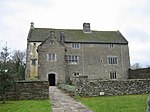Deep Navigation Colliery

Deep Navigation Colliery was a coal mine in South Wales, that operated from 1872 until 1991. Located next to the co-developed village of Treharris in the borough of Merthyr Tydfil, on development it was the deepest coalmine in South Wales Coalfield by some 200 yards (180 m). Producing the highest quality steam coal, it powered both the Cunard passenger steamers RMS Mauretania and RMS Lusitania in their successful attempts at the Blue Riband prize for the most rapid Atlantic Ocean passage. The mine is also thought to have been one of several locally that provided coal to the RMS Titanic; tests carried out on coal found in the ship's wreck have shown that most of the coal on board originated in South Wales. One of the first collieries in South Wales to have shafts wound by electricity, it was the first colliery in South Wales to have pit head baths for its miners. Profitable due to the quality of its coal, but financially degraded by huge volumes of water ingress throughout its working life, it was closed by British Coal on Good Friday, 1991. Today the wider local site, which was also occupied by the nearby Taff Merthyr Colliery and the Trelewis Drift Mine, has been redeveloped into the wildlife and leisure park, Parc Taff Bargoed.
Excerpt from the Wikipedia article Deep Navigation Colliery (License: CC BY-SA 3.0, Authors, Images).Deep Navigation Colliery
Millennium Park Walk,
Geographical coordinates (GPS) Address Nearby Places Show on map
Geographical coordinates (GPS)
| Latitude | Longitude |
|---|---|
| N 51.6678043 ° | E -3.3007479 ° |
Address
Millennium Park Walk
Millennium Park Walk
CF46 6AP , Treharris
Wales, United Kingdom
Open on Google Maps





